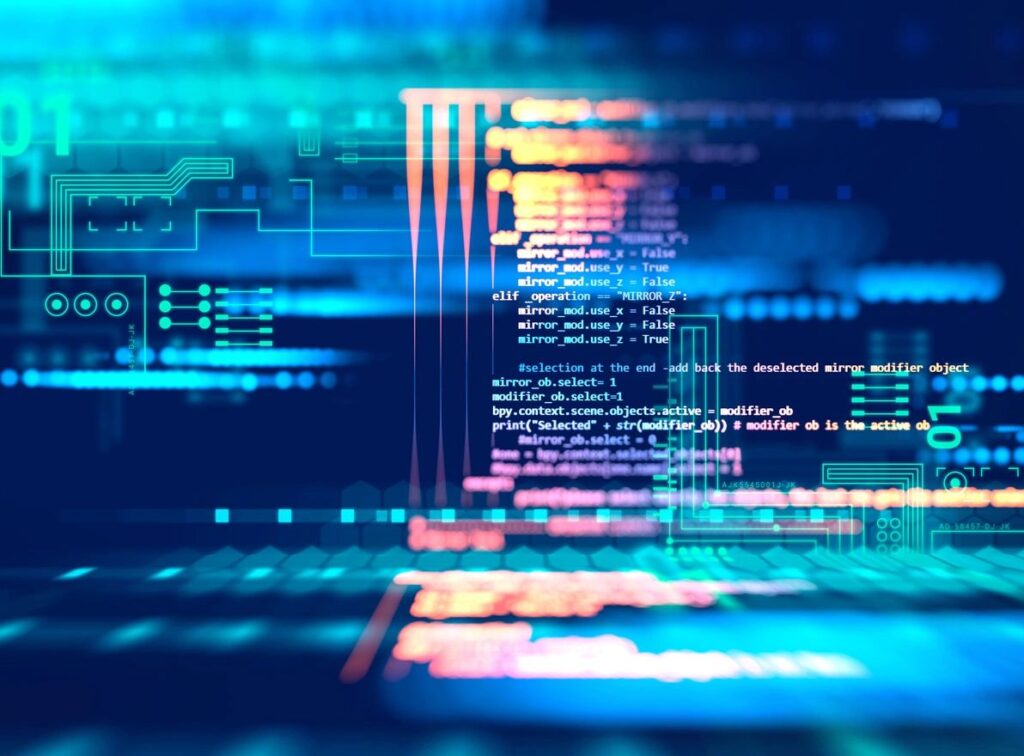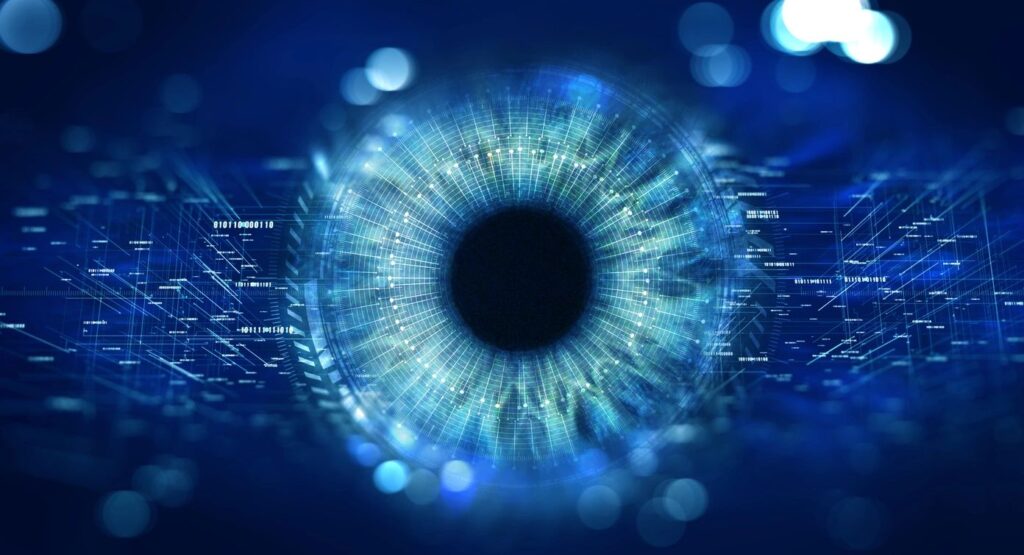Want to counteract threats and protect your data in today’s digital world? Learn how SaaSCom can help embrace the power of AI in cybersecurity and AI MDR tools. Contact us today.
There’s no arguing with the fact that AI is everywhere. It’s transforming customer experiences, revolutionizing network management, and even helping some companies to achieve their sustainability goals. One of the most valuable trends worth watching right now – however, is the rise of AI in cybersecurity and managed detection and response.
While AI has security challenges to overcome of its own, it’s also an incredible solution for companies tackling cyber threats and evolving risks. AI thrives on analyzing data, spotting patterns, and making predictions. When cyber attackers target networks, endpoints, or cloud environments, AI’s pattern-recognition capabilities can respond rapidly – often faster than humans can manage.
That’s why reports suggest the market for AI in cybersecurity will reach a value of around $219.53 billion by 2034. While there are various ways for AI to enhance cybersecurity practices, many business leaders are seeing a significant opportunity in the MDR space.
After all, around 40% of security leaders say they’re embracing tech to enhance security operations center processes today. Here’s your guide to AI in cybersecurity MDR strategies, and why now could be the time to update your technology stack.
The Rise of AI in Cybersecurity and AI MDR

Security teams have been battling cyber threats since the dawn of the internet – but the process has become increasingly challenging over the years, thanks to the rise of new cloud-based initiatives, and platforms. Year after year, companies have had to adapt, exploring new ways to rapidly identify and mitigate a more sophisticated selection of attacks.
In the early days, security relied on rule-based systems, which flagged down obvious threats but missed anything new or clever. Then the 1980s and 1990s introduced signature-based and heuristic-threat detection, starting to unlock opportunities for deeper insights.
In the early 2000s, vendors even started promoting anomaly detection systems that could hunt for unusual network behaviors 24/7. But it wasn’t until the rise of AI in cybersecurity, and AI MDR systems, that security strategies started becoming truly intelligent.
AI in cybersecurity introduced new opportunities for teams to start:
- Detecting attacks with fewer false positives, so teams can focus on real threats.
- Flagging suspicious emails (a common phishing vector) by analyzing language patterns.
- Simulating social engineering to reveal weak spots before criminals exploit them.
- Analyzing massive incident datasets for rapid threat containment and improved forensics.
AI MDR systems not only streamline security tasks, but they can also adapt much faster to changing threats and potential risks in a landscape that never slows down.
Use Cases for AI in Cybersecurity MDR Processes

AI MDR tools are rapidly gaining popularity, providing companies with a new way to implement a proactive strategy for addressing various threat scenarios. Let’s examine some of the top use cases where AI in cybersecurity really shines, providing significant value to organizations.
AI in cybersecurity MDR tools can help with tasks like:
Threat Hunting and Threat Intelligence
Modern threat hunting requires companies to go beyond reacting to alerts. Security teams need to proactively seek out hidden dangers. AI deep neural networks analyze logs and correlate data from multiple sources. They build threat profiles, detect unknown malware, and accelerate the detection of stealthy tactics. With AI, security teams can:
- Map threats to known indicators of compromise (IOCs).
- Spot unknown threats by learning normal activity baselines and flagging deviations.
- Process large data sets in minutes, far faster than a manual team.
Soc Operations
Security Operation Centers juggle an endless queue of alerts. It’s easy to miss something serious amid the noise. AI MDR solutions help by:
- Monitoring SOC KPIs like alert volume and response times, identifying bottlenecks.
- Prioritizing alerts so that high-risk threats get attention first.
- Automating triage for routine events, freeing analysts for more complex investigations.
Cybersecurity Training and Development
Training security analysts is vital, particularly when access to skilled security professionals is limited. However, when threats change constantly, delivering the right training is complex. AI in cybersecurity and MDR solutions can help. It can:
- Assess skill gaps by analyzing performance data.
- Generate simulations of real threats, turning training into a hands-on experience.
- Provide personalized learning paths, matching skill levels and areas needing improvement.
Data Analysis

Data analysis is critical in any MDR strategy, but today, companies need to look at more than just basic insights. They need to explore beneath the surface of threats with intelligence. AI learns how networks, devices, and users behave under normal conditions. That data can generate predictions about future threats. This helps with:
- Identifying insider threats who deviate from their usual behavior.
- Spotting compromised credentials with unusual login habits.
- Forecasting new attack trends, enabling proactive defense strategies.
Real-Time Threat Correlation
Attackers don’t just strike from one vector. They move laterally and chain multiple events. AI correlates data from endpoints, servers, and cloud services to build a complete threat picture. This approach:
- Uncovers multi-stage attacks that slip through single-point defenses.
- Recognizes patterns that point to advanced persistent threats (APTs).
- Cuts down response time, ensuring a cohesive defense across the entire environment.
Network and Cloud Detection and Response
Many organizations store critical data in multi-cloud or hybrid environments, that’s particularly true in the age of flexible work. The complexity can lead to misconfigurations. AI automates cloud threat detection by:
- Analyzing telemetry from various cloud providers in real time.
- Alerting on abnormal usage, such as unexpected data transfers.
- Reducing manual oversight needed to track multiple dashboards and logs.
Access and Authentication
User identity is a prime target for attackers, particularly when business employees are constantly using a wide variety of different apps and tools every day. AI in cybersecurity helps by:
- Analyzing login patterns for unusual access attempts.
- Detecting session hijacking or credential stuffing.
- Generating risk-based authentication prompts if something seems off.
The Benefits of AI in Cybersecurity and MDR

There are definitely challenges to using AI in cybersecurity and MDR processes (we’ll cover those in a moment). However, the benefits are astronomical too. With the right technology (and strategy, businesses from all industries can benefit from:
- Improved Threat Intelligence: AI sifts through massive datasets to identify emerging threats before they’re widely known. This predictive edge helps you patch vulnerabilities early, reducing the risk of being blindsided by zero-day attacks.
- Faster Incident Response Times: Time is everything during an attack. AI automates detection, analysis, and remediation, often within seconds. This speed cuts off attackers before they spread and reduces the scope of any damage.
- Enhanced SOC Efficiency: AI handles repetitive tasks, clearing routine alerts automatically. That lifts a big burden from SOC analysts. With fewer distractions, they can focus on complex investigations, improving both morale and effectiveness.
- Better Vulnerability Management: AI-powered scanners don’t just find vulnerabilities; they prioritize them based on factors like exploitability and business impact. That means less time patching low-risk issues and more energy spent defending critical systems.
- Accurate Breach Risk Predictions: AI considers asset value, threat exposure, and security controls to predict which parts of your infrastructure are most likely to be breached. This data informs budget decisions and helps you allocate resources wisely.
- Automated Recommendations: AI explains the reasoning behind threat alerts or recommended actions. That transparency is crucial for building trust among stakeholders and ensures that security teams make informed decisions quickly.
The Top AI MDR Tools and Vendors
At this point, you might be wondering which companies you should consider working with to leverage AI in cybersecurity. There’s no easy answer here.
At SaaSCom, we help organizations choose the ideal solution for their needs, based on their specific goals, challenges, budget, and even sustainable initiatives. If you’re looking for personalized guidance, contact our team for insights. However, if you just want an insight into some of the most impressive vendors offering AI MDR technologies, here are some of our top picks.
1. eSentire
One of the most impressive companies exploring the potential of AI in cybersecurity, eSentire is a market leader that offers organizations a huge selection of intelligent systems, from Managed Detection and Response technology, to digital forensics, incident responses, and continuous threat exposure management systems.
eSentire’s MDR service combines an open XDR platform (with over 300 integrations), multi-signal threat intelligence, and round-the-clock access to an elite threat hunting team. The result is a blend of cutting-edge technology and human expertise designed to neutralize threats before they become business-disrupting incidents.
A key differentiator for eSentire is its commitment to proactive security outcomes. Instead of simply reacting to alerts, their MDR service continuously identifies, prioritizes, and mitigates vulnerabilities. They report isolating 99.3% of threats at the first host, with a remarkable 15-minute mean time to contain. Another major selling point of eSentire, is it’s focus on securing new technologies.
For instance, the company offers a dedicated MDR solution specifically for generative AI applications. This revolutionary platform helps to provide protection against generative AI and LLM related threats, reducing AI blind spots on a massive scale.
2. IBM
IBM has been a heavyweight in enterprise technology for decades. Its Threat Detection and Response (TDR) services, which include MDR, bring together AI-driven capabilities, proactive threat hunting, and deep integration with the IBM portfolio.
One standout feature is the use of “Generative AI” to correlate threat intelligence with a customer’s unique environment. This approach allows IBM’s platform to map threats against frameworks like MITRE ATT&CK and then surface insights on the threats most relevant to your organization.
IBM also prioritizes something called “advanced threat disposition scoring.” Essentially, the AI models learn from analyst behavior to automate the triage of alerts, so benign events get filtered out automatically while high-risk activity is flagged for immediate attention.
The platform provides clear rationales for why certain incidents are deemed critical, ensuring that security teams build trust in the AI’s recommendations. IBM’s global presence, combined with strong consulting services, makes it a good fit for larger enterprises seeking a comprehensive, integrated security approach.
3. AirMDR

A relatively modern company in the world of AI in cybersecurity, AirMDR is one of the few organizations that has embraced artificial intelligence from the ground up – for truly next-level managed threat detection and response strategies.
AirMDR’s “Virtual Analysts” handle the bulk of routine case triage, reportedly automating over 80% of investigative tasks. These virtual analysts operate at machine speed, often scanning 90% of alerts in under five minutes. That speed is ideal for thwarting fast-moving malware or ransomware campaigns.
AirMDR’s Darryl bot also autonomously improves and learns over time, gradually automating more of your SOC tasks, to increase operational efficiency. Notably, with AirMDR, while the heavy lifting of various MDR processes is handled by AI – human experts still oversee the process.
AirMDR’s sweet spot appears to be small to midsize businesses that want enterprise-level protection without the enterprise-level expense. The blend of automation and human oversight can significantly boost the efficiency of a security team, allowing analysts to focus on the minority of alerts that truly demand expert review.
4. Cybots AI
Another company that puts AI in cybersecurity at the heart of its strategy, Cybots AI offers the “Advanced Managed Detection and Response” (ADMR) platform. This gives companies access to an intelligent system that helps to boost threat defense, without increasing manpower costs.
Many organizations wrestle with soaring security budgets and talent shortages. Cybots addresses this by combining 24/7 monitoring and AI-driven threat hunting, so companies don’t need to invest heavily in building an in-house SOC.
One of Cybots AI’s hallmarks is its automatic investigation capability. High-severity alerts trigger AI-driven playbooks that examine the data, checking for indicators of compromise or suspicious patterns. It’s a largely out-of-the-box solution with minimal configuration. For companies seeking solid, AI-based protection without extensive setup headaches, Cybots AI can be a strong contender.
5. BitLyft AIR
BitLyft’s AI-driven solution, BitLyft AIR, focuses on delivering proactive, always-on protection. Its real-time monitoring keeps a constant eye on network traffic and endpoint events, while predictive analytics anticipate attacks based on historical data. The system automates everything from threat detection to containment, aiming to reduce manual intervention whenever possible.
A major selling point for BitLyft is its focus on simplified user experience and intuitive dashboards. Some security platforms overwhelm analysts with complicated interfaces. BitLyft AIR is designed to present only the key metrics and recommended actions, allowing even smaller teams to respond effectively to all kinds of challenges.
BitLyft also allows companies to automate all kinds of processes, from risk scoring and incident response, to security orchestration. Plus, you still get access to human experts when you need more guidance from a creative, professional team.
6. Darktrace
Darktrace has long been a pioneer in AI in cybersecurity. Their Managed Detection & Response service builds upon more than a decade of applying machine learning to cybersecurity challenges.
The system constantly monitors data from multiple vectors- network, endpoints, cloud, operational technology, and SaaS—to spot the earliest signs of an attack. Darktrace’s AI learns “self” for each digital environment, so it can recognize subtle anomalies that signal malicious activity.
In March 2024, Darktrace introduced an expanded MDR service, featuring a global SOC team on standby 24/7. This human-AI collaboration ensures that once the AI identifies a threat, analysts step in to perform further investigation, add context, and – when necessary – initiate or extend remediation steps. The combination of advanced AI-driven detection and human oversight is a strong draw for organizations that want minimal dwell time for attackers.
7. CrowdStrike

Another company popular with organizations investing in security-led digital transformation, CrowdStrike made a name for itself with the Falcon platform, a cloud-native endpoint protection suite renowned for speed and accuracy. Their Falcon Complete Next-Gen MDR pushes that further by integrating endpoint, identity, and cloud telemetry into one cohesive unit.
What sets CrowdStrike apart is its track record of swift detection. Independent assessments, such as MITRE Engenuity’s ATT&CK Evaluations, have highlighted CrowdStrike’s ability to spot and neutralize threats faster than many competitors. The platform is powered by AI models that digest threat intelligence from global sources, coupled with a seasoned team of security analysts and threat hunters.
When a breach attempt is detected, CrowdStrike’s staff can intervene, contain the threat, and guide full-cycle remediation. This allows organizations to focus on business while CrowdStrike handles the firefighting. With adversaries adopting new tactics every day, CrowdStrike’s emphasis on intelligence-led threat hunting gives it an edge in tackling persistent threats and zero-day exploits.
8. SentinelOne
SentinelOne has taken an “autonomous security” approach, seeking to offload as many tasks as possible onto AI. The Singularity Endpoint platform and Vigilance MDR suite combine advanced threat hunting with immediate one-click remediation. If a file or process is identified as malicious, the system can shut it down and even roll back affected endpoints to their pre-attack states.
Companies that prioritize real-time containment appreciate SentinelOne’s speed and automated playbooks. The platform’s architecture is cloud-native, and it supports Windows, macOS, Linux, and diverse cloud environments, making it flexible for different deployment scenarios.
SentinelOne also invests heavily in user interface simplicity, so even smaller teams with limited expertise can deploy and manage the platform effectively.
9. Palo Alto (Cortex)
Palo Alto has been a leader in next-generation firewalls for years. With Cortex, they extend that track record to XDR (Extended Detection and Response).
Cortex XDR uses AI and behavioral analytics to spot anomalies across endpoints, networks, and cloud infrastructures. Xpanse, another piece of Palo Alto’s puzzle, helps map out an organization’s internet-facing assets, highlighting unknown services or misconfigurations.
The beauty of Cortex is its unified view. Instead of juggling separate tools for endpoints, firewalls, and the cloud, security teams get a consolidated dashboard. When combined with Palo Alto’s threat intelligence feed, Cortex can rapidly identify suspicious activity and automate steps to block malicious IPs or quarantine compromised endpoints.
For organizations already invested in Palo Alto solutions, Cortex offers an integrated evolution into AI MDR without a steep learning curve.
Trends Shaping the Future of AI in Cybersecurity MDR

We’re already entering a new age of AI in cybersecurity, thanks to the efforts of all the vendors mentioned above, and countless emerging startups. However, this is only the beginning. In the years ahead, numerous new trends will continue to emerge in this space, such as:
Advances in Machine Learning and Deep Learning
Machine learning models are becoming more capable, with techniques like reinforcement learning allowing AI to identify threats without constant human input, or massive amounts of labeled training data. Models can learn from smaller or noisier data sets, adapting to brand-new attack tactics fast.
Deep learning architectures may get better at analyzing network behavior, user actions, and cloud events in a unified manner. This means fewer blind spots and a faster grasp of suspicious patterns.
An especially promising area is unsupervised learning. Unlike supervised methods, unsupervised models can pick out anomalies all on their own, crucial for detecting zero-day exploits or insider threats that don’t follow known signatures.
Increased Integrations with Emerging Technologies
Cybersecurity and AI don’t exist in a vacuum. As quantum computing, blockchain, and the Internet of Things (IoT) evolve, AI-driven MDR solutions will integrate with these technologies to create more resilient defenses.
Some vendors are exploring how blockchain can securely store threat intelligence data, preventing tampering or data poisoning attacks. Others are examining IoT edge computing, using local AI models to detect threats in real time before they spread to a corporate network.
AI in cybersecurity systems and MDR solutions could even help companies tackle multiple challenges simultaneously going forward. They’ll help them identify threats, reduce risks, empower remote workers, and even achieve sustainability initiatives at the same time.
AI-Powered Remediation and Automation
Detection is only half the story in MDR. As AI models grow more refined, the industry is moving toward fully automated remediation. AI can isolate infected machines, block malicious IPs, or restore compromised systems to known-good states without waiting for human approval. This shift drastically shrinks the time attackers have to operate.
However, such automation must be tempered with robust testing and oversight. The last thing you want is your AI automatically shutting down mission-critical systems due to a misclassified threat. Many organizations start with partial automation- like auto-quarantine for known malware- before graduating to full-scale, AI-managed containment protocols.
Ethical AI and Explainability
Trust is a recurring theme with AI in cybersecurity. Stakeholders want to know how the AI reached a decision, especially when it comes to isolating systems or labeling certain files as malicious. Explainable AI (XAI) aims to make the decision-making process transparent, translating complex model outputs into human-friendly language.
Ethical questions also arise. AI can reveal sensitive data about user behavior or device usage. So, organizations must ensure they handle that data ethically, comply with regulations like GDPR, and balance security with privacy. As we move forward, transparency, fairness, and accountability will become integral parts of AI MDR solutions.
The Challenges to Overcome with AI in Cybersecurity

No technology is foolproof. AI in cybersecurity might deliver a lot of benefits to growing companies, but there are some serious challenges to address too, such as:
- Adversarial Attacks and AI Manipulation: Attackers can subtly alter inputs, tricking AI into missing real threats or generating phantom alerts that overwhelm security teams. Data poisoning is equally worrisome, potentially compromising the AI’s very foundation.
- AI Hallucination and Bias: Sometimes, AI sees patterns that aren’t there. If the training data is incomplete or biased, the model’s results can miss significant threats or over-prioritize trivial incidents. This can lead to both missed attacks and wasted resources.
- Regulatory and Ethical Hurdles: As AI grows more ingrained in security, regulatory frameworks will scrutinize data handling and automated decision-making more thoroughly. Organizations must remain compliant with privacy laws and ethical guidelines, ensuring that human oversight remains part of the equation.
Overcoming these issues starts with a careful focus on choosing the right security vendor or toolkit for your needs. Don’t just consider the pricing model, or the features your AI MDR system offers. Think about how it helps to navigate ethical threats, minimize bias, and ensures your company can adapt quickly and dynamically to new standards over time.
AI in Security and MDR Systems: Eliminating Threats
AI in cybersecurity is evolving quickly, bringing unprecedented speed, accuracy, and intelligence to threat detection. AI MDR tools give organizations an incredible opportunity to revolutionize how they detect and respond to an always-increasing number of threats.
Attacks grow more advanced by the day, but AI evolves just as fast, learning from past incidents and staying vigilant for new exploits.
The key to making the most of the AI revolution is choosing a vendor that aligns with your specific goals and requirements. SaaSCom is here to help. We offer expert consultancy and resources to help guide businesses towards the right technologies based on their priorities.
Plus, we work hand-in-hand with leading carbon offsetting programs, ensuring that the investments you make in protecting your business, can have a positive impact on the planet too.
If you’re ready to take a sustainable, intuitive approach to upgrading your managed detection and response strategy, we can help. Contact us today, and get ready for a new era of cyber safety.



